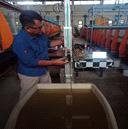
Wall-model perforated breakwaters have been widely used for coastal protection or harbor ponds as they have material-saving advantages compared to rubble mound breakwaters. But these breakwaters are less effective in reducing the energy and height of the waves at times of porosity of the pit () and the wavelength (L) of large ones. The use of a box-type culvert hole shape with a hole length of B in the thickness of the structure is expected to improve the performance of the breakwater in reducing energy and wave height with the porosity of the hole and the large wavelength.
The study was conducted to obtain the performance of box culvert-type perforated breakwaters in reducing energy and wave height based on indicators of transmission coefficient values (Kt), reflection coefficient (Kr), and energy dissipation coefficient (Kd). The research method is carried out with a theoretical approach using the Eigen Function method and physical model experiments in the laboratory. The results of the theoretical approach are compared with the experimentation of physical models in the laboratory to test their validity. Wave simulation on physical models using regular waves. The wave height is measured by a wave probe device placed in front of and behind the physical model. The parameters of the physical model holes (hL, B) and waves (H, T, L) are varied to determine the performance of the breakwater.
The results of this study can find the relationship of the influence of hole and wave parameters on the value of Kt, Kr, Kd and find empirical equations for calculating the value of Kt, Kr, Kd as an indicator of the performance of box culvert-type slot breakwaters. The results of the analysis showed that the value of the transmission coefficient (Kt) decreased with decreasing the value of relative hole height (hL⁄d), increasing relative hole length (B⁄L), and increasing wave steepness (H⁄L). While the value of the coefficient of reflection (K_r) applies the opposite relationship. The equation of K_t=0,075 (h_L⁄d)^0,839×[((H×B)⁄L^2 )]^(-0,323) with R^2 value=0,979 and K_r=-0,049 (h_L⁄d)^1,045×[((H×B)⁄L^2 )]^(-0,394)+1,0 with R^2 value=0,975 can be used to determine the value of K_t dan K_r box-type culvert-type hollow breakwater. The value of the energy dissipation coefficient (K_d) increases with increasing values of relative hole height (h_L⁄d), increased steepness of the waves (H⁄L) and the increase in the relative length of the hole (B⁄L), but after reaching the maximum Kd value i.e. when the value (H×B)⁄L2 is optimum, increased steepness of the waves (H⁄L) and relative hole length (B⁄L), the value of K_d will continue to drop. The optimum value (H×B)⁄L^2 value is 0,0034(h_L⁄d)^2,618 based on the used h_L⁄d and the value of the maximum dissipation coefficient (K_d) which is 0,70. The validation results show that the theoretical approach produces a value close to the experimental result if a culvert box hole coefficient of f = 2 – 3 is used.
Further recommendations and research need to be carried out to obtain the culvert box hole array and the design criteria of a strong and stable structure for application in the field. Further research using irregular waves also needs to be carried out so that it will be closer to the real conditions of waves in the field

Recent Comments